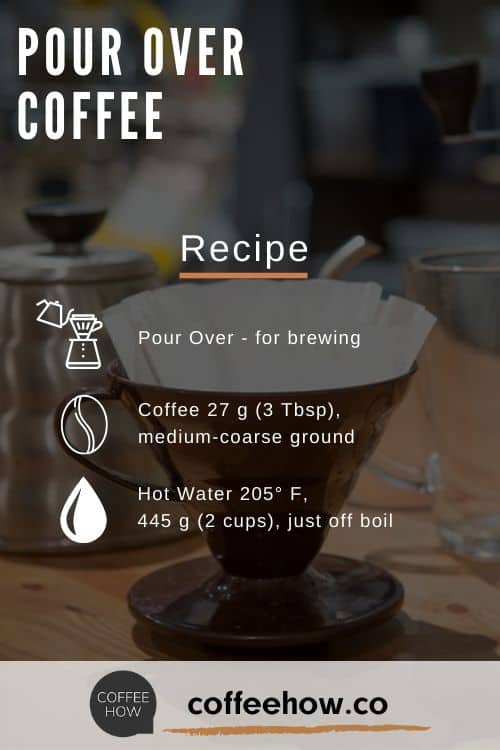Variations of French Press have been around for over 100 years, but design concepts as…
Big trends in coffee culture have a way of being so impressive they seem daunting and over-complicated for the average consumer. If that's you, then I'm here to reassure you that the pour-over coffee trend is the most straightforward way of enjoying a freshly brewed cup of joe.
For your convenience and to simplify things for you, I have developed an automated Pour Over Coffee timer-calculator. Use it. It will help you with ratios, the timing and will guide you step-by-step to your perfect cup.

Insert the filter on the funnel placed on the mug or kettle and pour a small amount of water through it to heat the dishes and remove the flavor of the paper

Get ready to slowly pour water through the pullover at a speed that will drain the entire volume of water in 2 minutes

Slowly pour water through the pour-over. You can use a trick and add 50 ml of water every 25 seconds 02:00
5 min · 1 cup · easy




In the early 1900s, percolated coffee was all the rage across Europe — but one German woman, a lady by the name of Amalie Auguste Melitta Bentz, was fed up with the stray grounds and signature intensity of a cup of percolated coffee. In her quest to brew a cup of coffee that satisfied her picky palate, she devised the first version of the pour-over funnel: a brass pot with a hole punched through it and blotting paper inside to act as a filter.
It’s a rough start to a trend that can now set you apart from the crowd as a sophisticated coffee enthusiast who appreciates a perfectly portioned and extracted cup of the good stuff. These days, a great deal of discussion can be had around exactly how much a pour over coffee ratio of coffee to water should be or how fine a pour over coffee grind size should be used.
Don’t let diving into all those details intimidate you if you’re just getting started. I know from personal experience that knowing how to make pour over coffee is only as difficult as you make it out to be, in the end. And sure, freshly ground coffee is ideal, but pour over is a great way to perk up even the most mediocre prepackaged grounds.
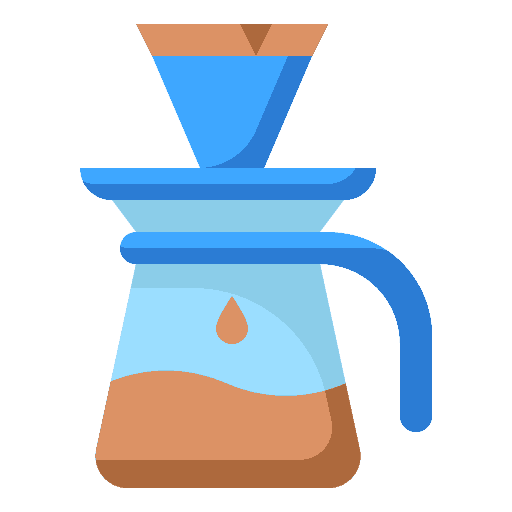
If this is your first pour over, make sure to read through each step first before you start. Timing is everything with this method of brewing and you don’t want to find yourself on the wrong end of a timer while you’re reading up on the next task. Even if you know your way around how to use Hario coffee makers and the like, it doesn’t help to go over the basics.
Standard practices for brewing almost any type of coffee that calls for hot water set the ideal water temperature between 195-205 degrees Fahrenheit (90-96 degrees Celsius). That leaves you with a 10-degree margin to play around with when it comes experimenting on your own, which AeroPress pour over enthusiasts are known to do. If you split the difference and aim for about 200 degrees Fahrenheit (93 degrees Celsius), you should be pleased with the results.
You can use tap or hot water for the filter rinse, though hot water is more common. There are different schools of thought about what this step really does for the overall flavor of the final cup, but most agree it’s better safe than sorry. The prevailing belief is that wetting the filter first rinses off any loose paper fibers and prevents the filter from soaking up too many of the flavorful components of the coffee as it brews through it. If you rinse your filter over the cup you’re brewing into, remember to toss out the water that drains into it before starting your actual brewing process.
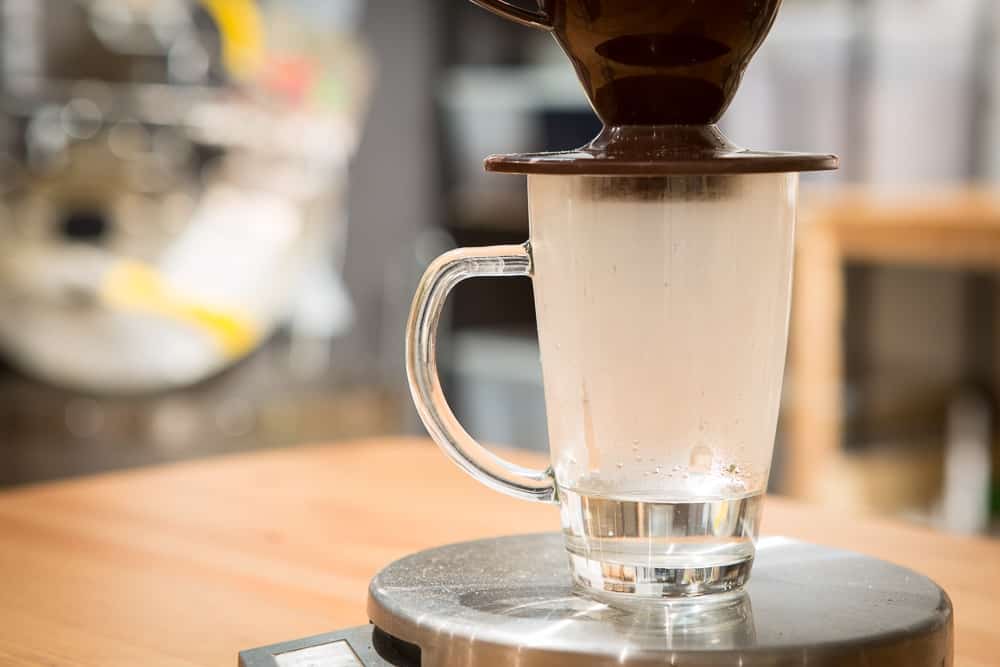
Drippers can be manufactured in a variety of ways for a pour over experience, but the most popular models are made to fit over the average-sized coffee mug. Demitasse cups are too small for most drippers and extra-large coffee “bowls” are too wide. If you want to make an extra-large amount of pour over, consider something like a Chemex dripper and carafe set.
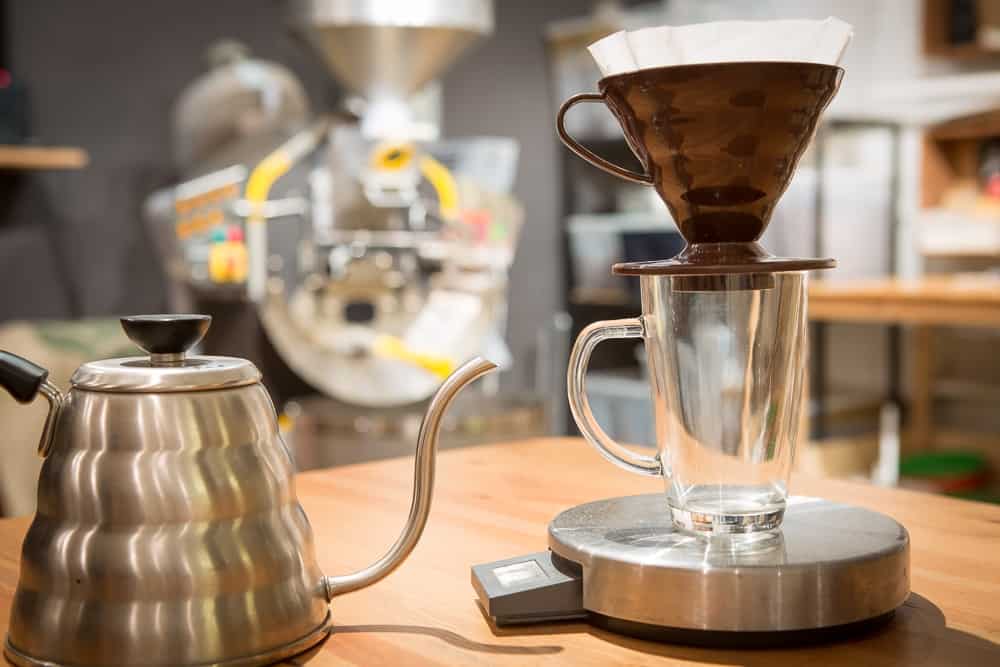
If the National Coffee Association USA (NCA) is comfortable claiming a standard ratio of coffee to water is around a tablespoon or two of coffee grounds to six ounces of water, then I’m inclined to tell you that you don’t need to weigh your coffee out to the exact milligram to get a drinkable cup brewed.
Having said that, I’m also obligated to inform you that you’ll probably have a better brewing experience if you do carefully measure your coffee by weight rather than volume. This is because inconsistent grind sizes can yield different volumes — measured by weight, consistent grind size doesn’t play as critical of a role. You can shoot for a 1:17 coffee-to-water ratio as a start, which means you would need about 10-11 grams of ground coffee to make that 6-ounce cup prescribed by the NCA.
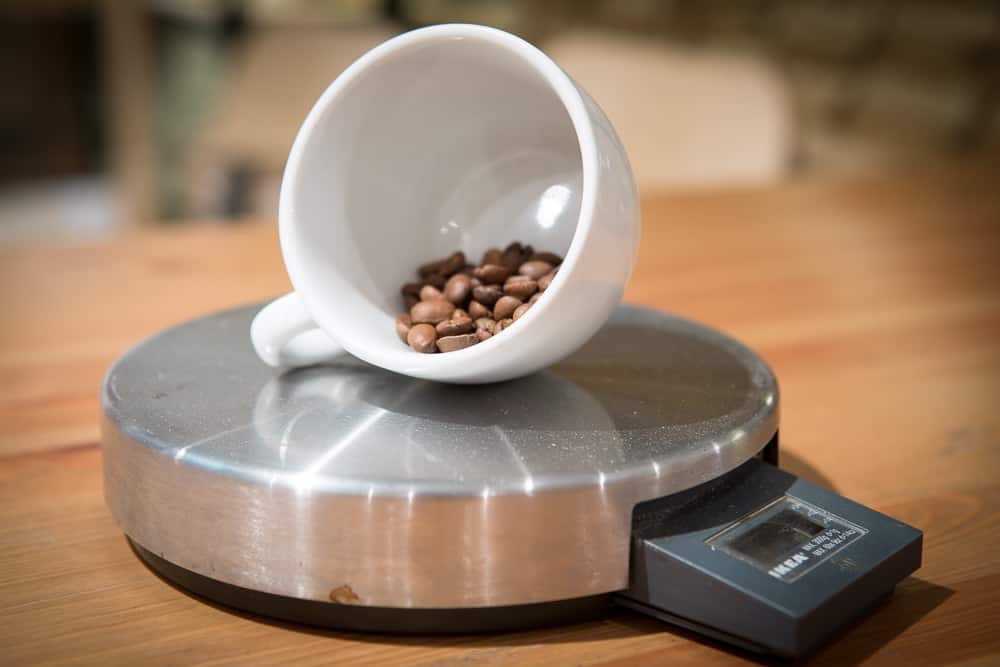
Speaking of pour over coffee ratio and pour over coffee grind size comparisons, you should be looking for a medium-coarse grind for most pour over methods. The pour over coffee grind size is pretty much the same as the off-the-shelf grind size found in most prepackaged coffees that are sold for automatic drip brewers. In the FAQ down below, I explain more about drip and pour over differences — spoiler alert, these brewing methods actually have more in common than not!
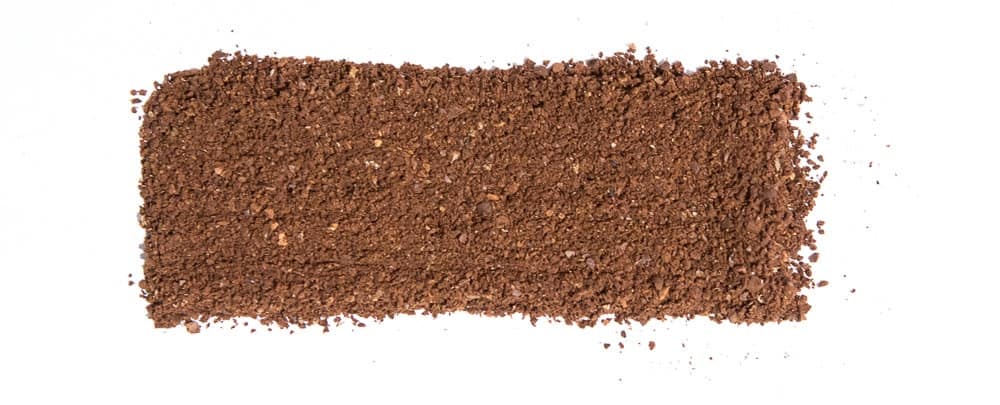
It’s tempting to make every step of a manual coffee-making method an opportunity to finesse the process a little, but you don’t have to be too picky about how you get the ground coffee into the filter. There’s no need to sprinkle it down like a soft rainfall with a Salt Bae flair. You may find aficionados arrange it into a mound or, in opposition, create a divot in the center to help with even saturation. I know my way around coffee, but I’m not the one to make a guess on the hidden science of how to put coffee into a pour over filter.
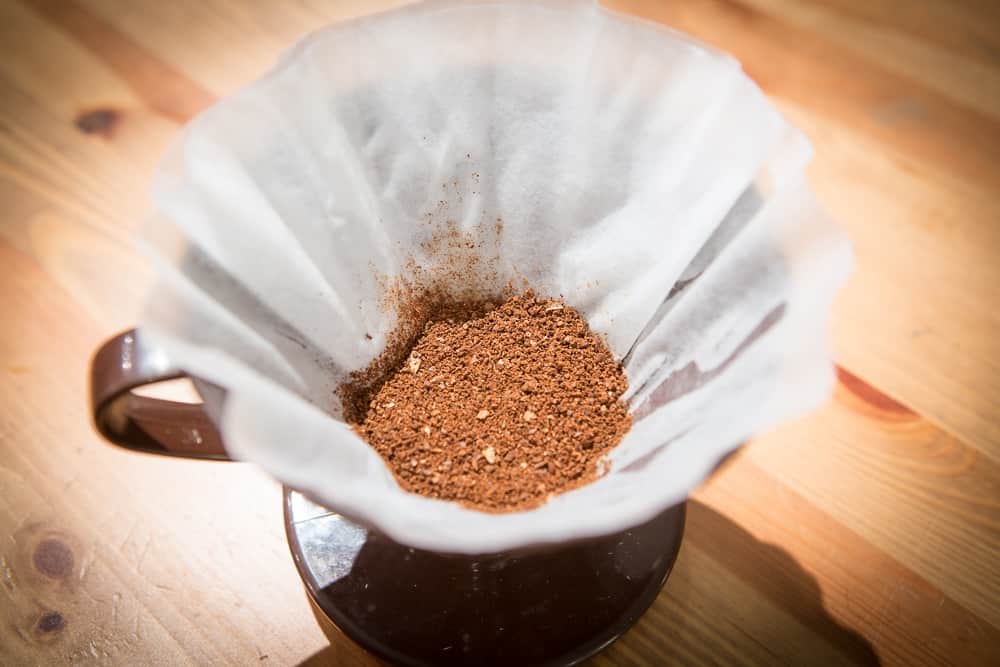
While I’m not convinced there’s any point to how you stack your grounds in the filter, I am certain that blooming your coffee grounds is a must. The science here is proven so well that many modern auto-drip brewers have a built-in blooming timer. The process is simple, but it is time-sensitive. You introduce a small amount of hot water by pouring a thin stream around the outside and inward until you reach the center. The goal is to get all the coffee wet, but not enough that it starts to drip.
Then, you wait.

I mean it! You wait, but not for long. Though a coffee bloom need only last about 15-20 seconds, it’s a crucial amount of time in which you should leave the coffee completely undisturbed. Like temperature, bloom time can withstand a little experimentation depending on your setup. You should at least wait 20 seconds, but you can push that to a minute, perhaps a minute and a half if you’re interested in exploring just how much flavor you can extract from your beans before you’ve gone too far.
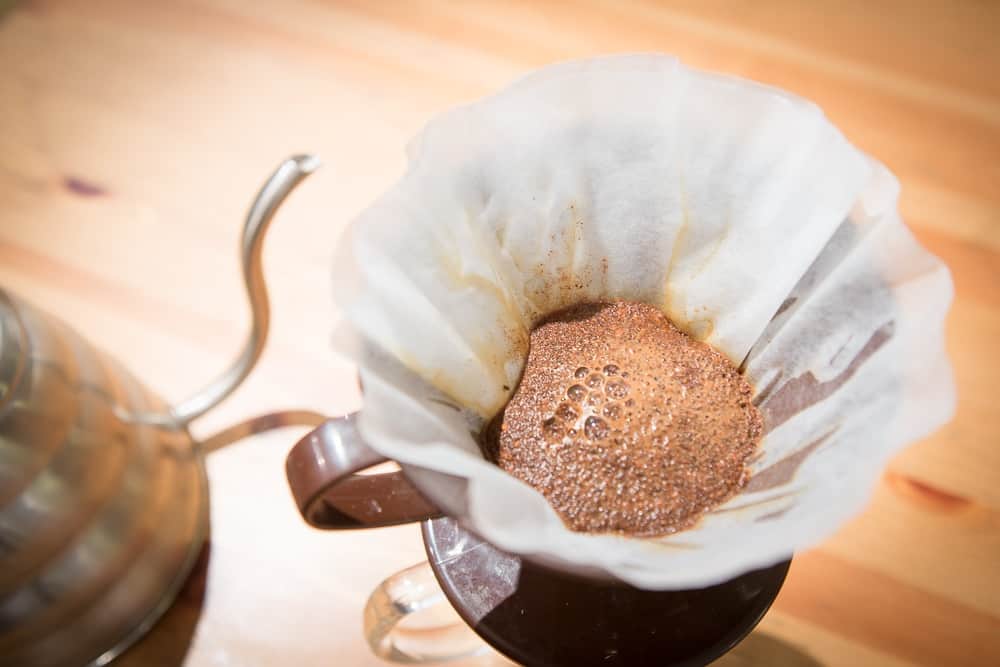
Get ready to slowly pour water through the pullover at a speed that will drain the entire volume of water in 2 minutes
There’s an art to the actual pour-over moment, the defining characteristic that elevates this brewing method to the trendy heights it enjoys. Not only should you be careful about how much water you’re pouring over your coffee, but you should be mindful of how quickly, too. Even, consistent saturation of the coffee is key to producing the best flavor. Some enthusiasts employ the use of a timer in addition to a scale so that they can match the rate at which they pour to the amount they’re pouring. This is high-tech and high-maintenance, but you can’t deny those amazing results!
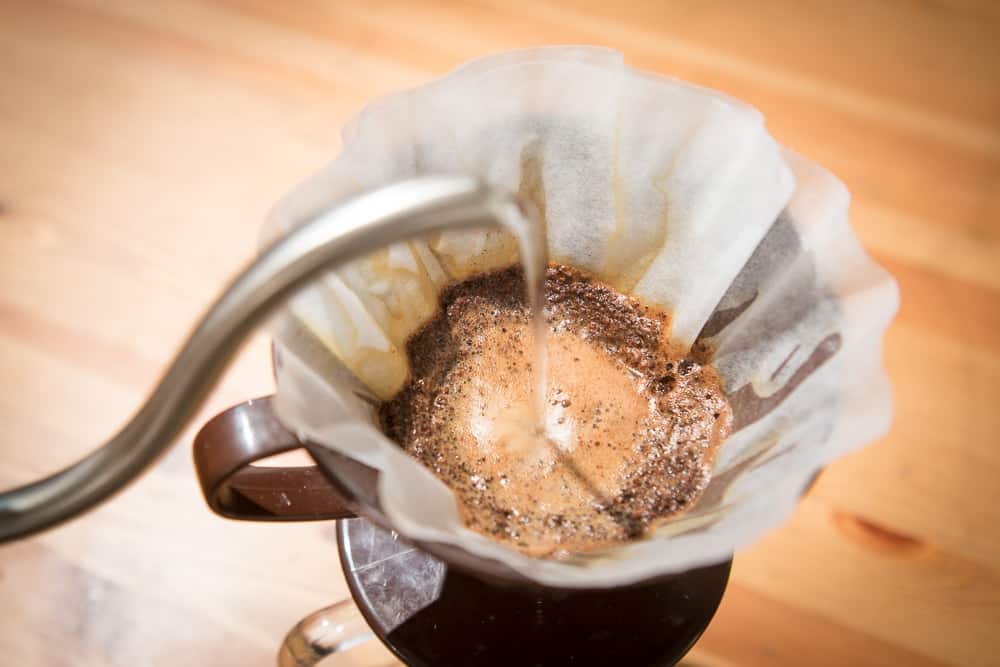
However, you manage to make it to the end of your pour, know that you’ve earned a moment to enjoy the fruits of your labor. Manual coffee-making doesn’t offer instant gratification, but it does provide you with an ultimate coffee-drinking experience that is as fresh as it can get.
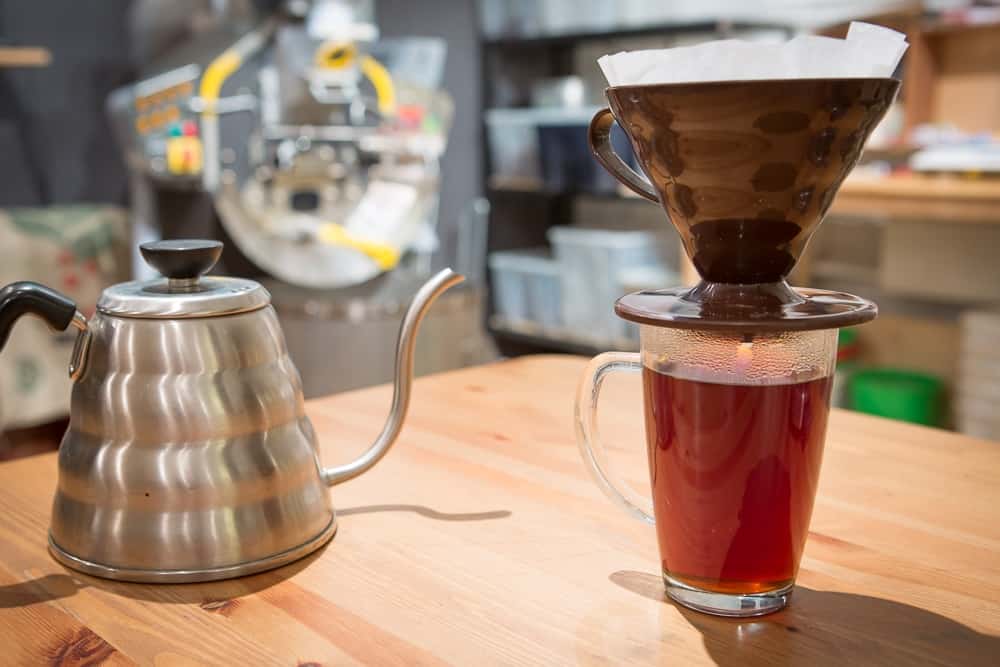
Volatile oils give coffee its unique flavor, but the build-up of these oils can also make future cups of coffee taste awful as they turn rancid over time. Plain white distilled vinegar will help you get rid of any residue on your coffee-making accessories, so clean them regularly to keep your brews tasting as fresh as possible!

Although the pour-over process is largely the same from one device to the next, there are a few brand-specific notes I can share with you so that you can feel confident brewing pour overs no matter what you’re using. How much coffee pour over coffee makes is also brewer-specific, which can be a deciding factor when it comes time to purchase a device.
While this dripper looks like your conventional, no-frills pour over coffee maker, the Clever Dripper is hiding a smart little secret. It combines the technique of a pour over with the technology of a valve-release immersion brewer. Hot water submerges the coffee grounds in the filter until you place the dripper on top of your cup.
Then, the magic happens. It triggers the valve to release and the coffee to stream down into the cup, piping hot and full of flavor. This is the brewer for anyone who thinks the standard pour over process is too finicky or too time-consuming. You can pour the water and make breakfast while it brews for 2-4 minutes per the brand’s pour over coffee coffee instructions.
There’s no big, impressive trick for how to use V60 drippers. They’re one of the most popular drippers on the market for a reason, and that’s because they’re durable and easy to keep clean. Made of ceramic, it’s a dripper that holds on to heat well. Its signature spiral rings prevent filters from suctioning to the sides and allow coffee grounds plenty of room to expand.
Once you learn how to use Hario coffee makers, you’ll always have an easy and portable way of making delicious coffee. The only complaint most people have after they learn how to use V60 funnels is that you can really only make one great cup of coffee at a time.
Hario V60 is actually one of the favorite brewers. A famous coffee quote “coffee is not only about the caffeine content”, but it is also about the experience. You sacrifice convenience for a better flavor.
Like the Hario, the Bee House dripper is made of ceramic and uses a cone-shaped design for its over-the-cup fit. Rather than a mug-like handle, it has an adorable lip that comes up and away far enough from the main body of the dripper that you can be sure it won’t remain too hot to handle while brewing.
I’m also relieved to tell you that the Bee House dripper won’t require you to go out and buy some fancy new type of filter — the standard #4 cone-shaped paper filters work just fine, though they do tend to stand a little tall once seated. The pre-brew filter rinse keeps it in place easily, however.
Although Chemex as a brand has more than one manual brewer on the market, the classic design describes an all-in-one funnel and carafe made of handblown glass. These hourglass-shaped coffee makers look like modern works of art sitting on most countertops. If you want to flaunt your pour over clout, this is the brewer for you.
Their design and function work simply enough, so don’t let the fashionable looks fool you into thinking it takes more than the normal amount of skill to make good pour overs with a Chemex. They’re also a favorite choice if you consider how much coffee pour over coffee usually makes and find you want something that can brew more than one cup at a time. Chemex brewers come in sizes large enough to hold 40 ounces of coffee!
Details matter, so Kalita makes its Wave dripper in stainless steel, glass and ceramic so you can choose the exact right dripper for your preferences. The handles have a heat-safe grip, a thoughtful move that anyone with sensitive fingertips will be grateful for.
Rather than a cone-shaped funnel, the Kalita Wave holds a flat-bottom basket-style filter. If you find cone-shaped filters aren’t a good match for your pouring style and you’re struggling to saturate coffee grounds evenly and consistently, you may find switching to a flat-bottomed filter like the kind the Wave takes will work better for you.

There’s no such thing as a bad question, and when it comes to making sure you’re drinking good coffee, I want my readers to know everything they can. Let’s take a deeper dive into the world of pour overs.
Any slow, even pour that soaks the coffee grounds consistently and thoroughly is going to produce good results. It’s best to work in circles that start from the outside and spiral in, then back out again. I agree with the trend of using a goose-necked electric kettle; it gives me the most control over how much water I’m pouring. It also keeps backsplash to a minimum. The last thing I need to is to nurse a burn while I’m trying to enjoy my coffee!
If you’re grinding it fresh for the cup you’re about to brew, it’s automatically the best coffee compared to anything you’ll be preground. If all you have is preground, then you’re in luck! Pour over brewing is the best way to get the most out of a coffee that might have lost some of its flavorful edge once it’s been ground and stored for a while. Third-wave coffee trends favor light roasts for brewing methods like a pour over. The way water-soluble compounds are extracted highlights the more unique, vegetal flavors of coffee beans.
When you’re talking about differences between a drip-brew coffee maker and a pour-over coffee maker, you’re probably discussing automatic versus manual brewing methods. Essentially, pour overs are a type of drip-brewed coffee. Water passes through the coffee grounds and out of a small hole at the bottom of a funnel or basket in a steady stream. With a pour over, of course, you’re the one working the water piece of the coffee-making puzzle. An automatic drip-brewer uses a pump and a nozzle.
For most people, the beauty of an over-the-cup pour over brewer is its simplicity. Most are made of a durable type of ceramic, plastic, glass or metal. If you’re worried you may knock your dripper around a lot, get a plastic or metal one. If you want a beautiful statement piece that looks great on the counter and is easier to keep clean, go for ceramic or glass.
Metal filters (made of stainless steel as opposed to aluminum since aluminum is known as a reactive metal, which doesn’t play nice with acidic compounds) are a great solution to the classic problem of waking up to realize you don’t have any filters left. There’s nothing worse than leaving the house before your first cup of coffee, especially if it’s to get filters to make said first cup of coffee. However, you can expect to taste more of your coffee’s volatile oils. This can come off quite pungent or even too potent for some coffee lovers.
If you’re one of the above-mentioned coffee drinkers who find coffee brewed with a metal filter or in a French Press is just too intense, you’ll want to use a paper filter. It holds back more of those flavorful oils, which creates a smoother taste and a milder finish. Rinsing paper filters prevents them from sucking up too many of those tasty components, though, and it helps the coffee to filter evenly throughout the brew, so you’ll see this step noted in almost every pour over coffee recipe.
Blooming allows coffee grounds to release their flavorful, water-soluble compounds — without having to immerse them in a long brewing process that runs the risk of overextraction. Essentially, you’re waking the coffee up before putting it to work through a brew cycle. Even if your favorite pour over coffee coffee recipe doesn’t come with a note on blooming your coffee, take a little extra time to do it anyway.
Learning how to make pour over coffee offers you a unique and rewarding experience that gives you total control over how your coffee brews. Pretty soon, you’ll be the one crafting your own set of pour over coffee instructions to pass along to your friends!
